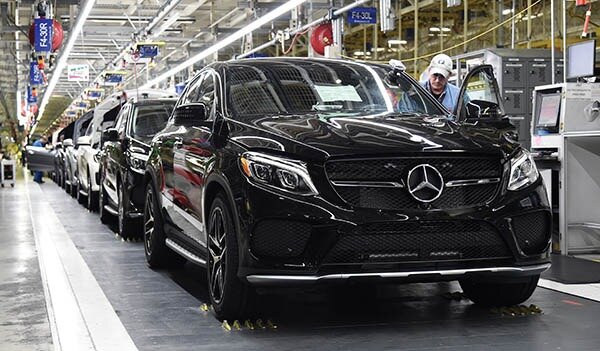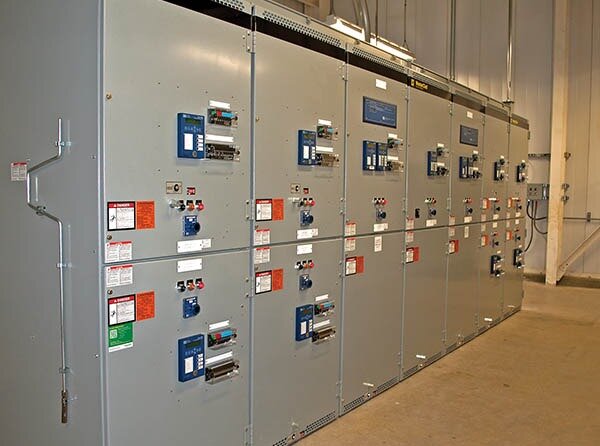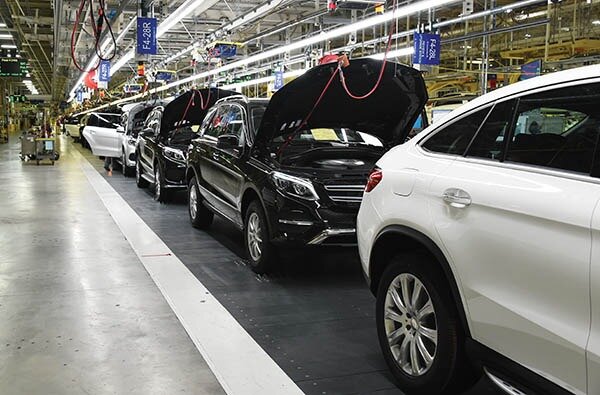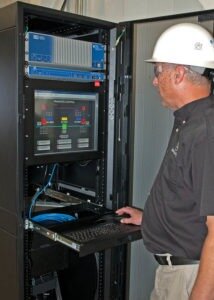Powering Auto Production—Mercedes-Benz Robust Power System
/A highly sophisticated electrical protection and control system helps Mercedes-Benz keep the power running and its people and equipment safe.
By Michelle Segrest, Navigate Content - Reporting for Maintenance Technology Magazine





When electric current flows through an air gap between conductors, it creates an arc flash. Sparks fly. Equipment can explode. And anyone who happens to be nearby can be injured—or even killed.
“The heat and light energy radiating from an arc flash is so intense it can do extensive damage to the equipment and can pose a very dangerous hazard for workers who are exposed to it,” explained Randall Sagan, an electrical engineer who is responsible for designing the power system for the 8.5-million-sq.-ft. Mercedes-Benz U.S. International Inc. (MBUSI) facility in Vance, Alabama.
“The faster a breaker can trip to turn off power and extinguish the arc, the less energy is emitted and, therefore, the risk from injury is reduced.”
The risk of an arc-flash event is one of the reasons power-system maintenance is the single most dangerous activity technicians perform in a year’s time at this facility. “The maintenance teams don’t normally work on the power system very often,” Sagan said.
“When you consider utility substation crews working on substation equipment every day—they are very good at it because they practice the same types of activities over and over. Our maintenance teams may be working on chillers, air compressors, pumps, or air filters most of the time. And then once a year, they go do power system maintenance. Now they need to open and close breakers, rack breakers out of their cubicles, and put safety grounds on the cables. This is not something they do every day. The danger is real, and these guys understand the risks involved.”
Historic Mercedes-Benz Manufacturing Plant in Alabama
Mercedes-Benz is a global automobile manufacturer—a division of the German company Daimler AG, headquartered in Stuttgart, Baden-Württemberg. The brand is known for its luxury vehicles, buses, coaches, and trucks.
In 1994, the company broke ground in Vance to build its only North American manufacturing facility. The company chose the 1,000-acre spot between Tuscaloosa and Birmingham because of its proximity to the interstate, a railroad, and utilities. Alabama Power worked as a partner and built an on-site substation to provide power only to this Mercedes-Benz plant, which produces more than 300,000 vehicles annually. The facility manufactures models GLS, GLE, GLE coupe, and some C-class sedans.
The company hired Sagan for his experience designing power systems at Kentucky Utilities and the Georgetown, Kentucky Toyota Motor Manufacturing facility. “When I got here [MBUSI], this was just a big muddy field, and the power system was a blank sheet of white paper,” he recalled. “You talk about an engineer’s dream come true!”
A Need for Redundancy in Auto Manufacturing at Mercedes-Benz
For Sagan, the main focus for the original power system design was redundancy. “I knew that this would give us more flexibility for performing maintenance, as well as providing a more reliable system in the event of a failure,” he said.
Sagan explained that mechanical systems typically use “N+1” redundancy. “If you need three pumps, then you install four. That way if one of the pumps fails, you turn on the backup,” he said. But for a power-distribution system to be fully backed up, “2N” redundancy is required. This means each major piece of equipment has a backup installed—one for one.
“Alabama Power fed the plant with two substation transformers,” Sagan said. “We essentially designed two complete power-distribution systems in the plant. Each one is a mirror image of the other and is fed from each of the Alabama Power transformers. This 2N redundancy approach was carried all the way down to the 480-volt bus duct distribution systems in each of the shops.”
Tie breakers at the main switchgear and at each unit substation provide the ability to back feed a section if something fails or needs to be shut down for maintenance.
Massive Power, Reliability & Safety in Automotive Production
A recent plant expansion to accommodate an increase in production capacity created a need for increased power. The original power system Sagan designed has operated efficiently and effectively for the past 23 years, but the increased load was going to exceed the capacity of the main “M1” switchgear and require a new lineup of medium-voltage switchgear, “M2.” Sagan used this opportunity to implement a safer and more reliable protection and control scheme.
“The original concept was to copy what we had on M1 and make M2 match,” explained Sagan. “I met with relay manufacturers and asked them to show me what features were available in this day and age. There was some pretty impressive stuff, but it seemed like everything was focused more on reliability. I was more interested in improving safety. While reliability is certainly important, a lot of the protection schemes they were showing me were way more complicated than what I thought I needed for a car plant.”
During an internal presentation, a sales engineer mentioned how faster circuit breaker tripping times improved power system reliability. That caught Sagan’s attention, and he asked about the impact on arc-flash mitigation. From that point forward, the discussion focused on a protection scheme that emphasized safety.
“Of the hundred or so different options available, I picked out the six or seven that made sense for this project,” Sagan said. “Without making it overcomplicated, we came up with a design that utilized much more advanced components and would achieve a safer system. This is the safest medium-voltage switchgear in any Mercedes-Benz facility in the world.”
Communication-Assisted Protection and Control at Automotive Facility
One of the main features that makes switchgear so safe is the communication-assisted protection and control scheme. Sagan explained that all of the relays are connected by a fiber-optic network to an automation controller. The automation controller is located in an HMI (human-machine interface) cabinet a safe distance away from the switchgear. This allows an operator to open or close circuit breakers from the HMI screen rather than operating a control switch while standing right in front of the breaker.
“If there is a fault or a problem with the breaker when it is opened—like an arc-flash event—and you are standing right in front of it, you are at risk of being injured from the arc flash,” he emphasized.
Another major component that improves the safety of the M2 switchgear is the arc-flash-detection system. This system uses 44 arc-flash sensors embedded throughout the switchgear. Each relay has four sensors connected by fiber-optic cables. If an arc flash occurs on the part of the circuit protected by a specific relay, light is transmitted to the relay from the sensors. This, along with the fault current detected by the relay, causes the relay to trip its circuit breaker extremely quickly.
“This is the fastest any relay can detect and issue a trip command on any Mercedes-Benz power system in the world,” said Sagan. “Because the relays are able to trip circuit breakers in less than 7 milliseconds, the arc-flash energy is drastically reduced.”
Each feeder relay also has arc-flash sensors in its main bus section. In this case, if a short circuit occurs upstream of the feeder breaker, the relay transmits a message through the fiber-optic network to tell the main relay that an arc flash has been detected. This allows the main breaker to trip and extinguish the arc flash 10 times faster than is possible on the M1 switchgear.
Most industrial plants rely on traditional time-current-coordination protection schemes for their medium-voltage switchgear. In this type of scheme, relays on the main breakers have a time delay to coordinate with downstream relays. This prevents the main breaker from tripping for a fault on one of the feeders and shutting down the whole bus. But, if the fault is on the main bus, the main breaker still has to trip.
“The breaker may delay as much as one second before it trips,” Sagan said. “That is a long time in the arc-flash world, which means that you could be severely injured or even killed if you are exposed to the energy from that arc flash.”
To overcome the time-delay problem with the main breakers, Sagan again used the high-speed fiber-optic network communications. “Because all of the relays can communicate with each other, the system is able to distinguish between a fault on one of the feeders and a main bus fault. This allows the main breakers to trip much faster, thereby reducing the arc-flash hazard.”
Auto Plant Expansion Requires New Infrastructure
The 1.2-million-sq.-ft. body shop expansion project also required increasing the assembly and paint shops. Several loads were re-circuited to the new M2 switchgear to free up capacity on M1. New circuits were then installed at M1 to feed the new body-shop expansion.
“By doing this, I was able to rebalance the plant loads and maintain the full 2N redundancy throughout the system,” Sagan said. “We literally now have the ability to fail half the transformers in this plant and still run full production.”
Sagan explained that his experience earlier in his career made him realize how important backup redundancy was for the power system.
“Not only does this provide flexibility for supporting production in the event of a failure, but it also allows us to shut down major parts of the system for maintenance,” he said. “Instead of having to schedule maintenance blackouts, we simply transfer the load using the redundancy. Then we can perform maintenance testing during the week on straight time, instead of having to make a mad dash to get it all done over a weekend.”
Power System Technology’s Safety Benefits
Safety was a major emphasis for Sagan when he was designing the new unit substations for the plant expansion. Power-system studies revealed that the most dangerous arc-flash hazards in the plant were found at the 480-V main breakers at the unit substation transformers. A typical unit substation steps down from 13.8 kV to 480 V for distribution in the shop areas. In a conventional transformer protection scheme, the primary disconnect switch has fuses that protect the transformer.
“The problem is that if there is an arc-flash event when someone is opening or racking out a 480-volt main circuit breaker, you are relying on the fuses on the high side of the transformer to blow to turn that arc flash off,” Sagan explained. “Because the fault current has to go through the windings of the transformer, the fuses are operating in their time-delay range. The amount of current available at the transformer, and the longer clearing time of the fuses, result in extremely high levels of arc-flash energy. There is no personal protective equipment available that can protect a person in that situation.”
To mitigate such dangerous levels of arc-flash energy, Sagan used a transformer differential protection scheme on the new unit substations. The fuses in the primary disconnect switch are replaced with a medium-voltage vacuum circuit breaker. A differential relay measures the current going in and coming out of the transformer. If there is a difference between the two, then the relay assumes there is a short circuit inside and issues a high-speed trip command. The relay also has the ability to detect fault current on the 480-V main breaker.
“Because it can trip the primary circuit breaker so much faster than fuses would operate, this scheme reduces the arc-flash hazard to much safer levels,” Sagan explained. “All of the new substations utilize that scheme. And, with the addition of remote-control panels for all of the circuit breakers, the whole unit substation is much safer to operate.”
A substation such as this may have between 15,000 and 20,000 A of fault current available. The arc flash that would be created could be between 30,000 and 35,000ºF—four times hotter than the surface of the sun.
“We are definitely dealing with extremely high levels of energy,” Sagan said. “It can be extremely dangerous to workers who have to interact with this gear. By utilizing protection schemes that are designed to reduce the arc-flash energy levels, we are also in effect making the system more reliable. An arc flash with that much energy could kill somebody and is also doing a tremendous amount of damage to the equipment. So, if I can reduce the amount of damage to the equipment, I may also be able to reduce the cost to repair or replace it.”
Sagan achieved his goals to make the power system safer and more reliable. With almost four decades of experience, he said he considers this the greatest engineering achievement of his career.
And it all started with a blank page and unlimited opportunity.
PLANT EXPANSION AND NEW PRODUCTS
It has been 20 years since Daimler-Benz AG (now Daimler AG) surprised the world and selected Alabama as the home for its first full passenger vehicle plant outside of Germany and in North America.
As a result of the worldwide success of the M-Class (now renamed the GLE), Daimler AG has continually invested, expanded, and more than tripled production at MBUSI. We now build the GLE, GLS, GLE Coupe for the world, and the C-Class for North America.
In 2015 annual production was 303,000 vehicles. Roughly two-thirds of the components used in MBUSI-built vehicles come from North American suppliers, and about 30 first- and second-tier suppliers are now located in Alabama. We distribute to 135 markets worldwide with 60% for export.
As of today, Daimler AG has invested over 4.5 billion and continues to invest in MBUSI in Tuscaloosa County, Alabama. MBUSI is responsible for more than 22,000 direct and indirect jobs in the region and has an annual economic impact of more than $1.5 billion. MBUSI is also the state's largest exporter, with more than $1 billion in exports each year to over 130 countries around the world.
A FEW FACTS ABOUT MBUSI
MBUSI has been located in Tuscaloosa County, Alabama since 1995.
MBUSI is the first large Mercedes-Benz production plant outside Germany.
MBUSI is the first major automotive manufacturing location in the State of Alabama – serving as the catalyst for additional OEM, automotive suppliers, and supporting businesses to come to the area.
MBUSI has more than 3,800 employees with an estimated additional 10,000 indirect jobs at suppliers and service providers in the region.
MBUSI has, so far, invested more than $6 billion.
MBUSI is investing an additional $1 billion to start production of electric passenger cars, expand the plant’s logistics activities, and to build a battery factory.
The MBUSI Consolidation Center started operating in 2019.
Construction activities for the battery factory started at the end of 2018; the battery factory will go into operation at the beginning of the next decade.
Future battery production will be part of the global network of Mercedes-Benz Cars, both for the local market and for export.
MBUSI builds the GLS, GLE, GLE Coupe exclusively for the world market.
MBUSI is the second largest automotive exporter in the U.S.
Around two thirds of the SUVs produced at MBUSI are being exported to almost every country in the world.
Since 2014, MBUSI has produced the C-Class for the North American market.
More than 3.2 million vehicles were built since 1997.
There are almost 200 U.S.-based suppliers with localization rate continually increasing.
Michelle Segrest is President of Navigate Content, Inc., a full-service content creation firm. She has been a journalist for more than three decades and specializes in covering the people and processes that make a difference in the industrial processing industries. Contact her at michelle@navigatecontent.com
Originally published in Maintenance Technology, July 2017. Updated October 2019.







